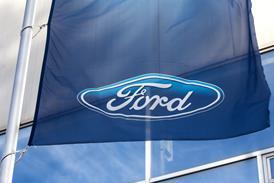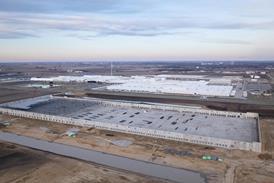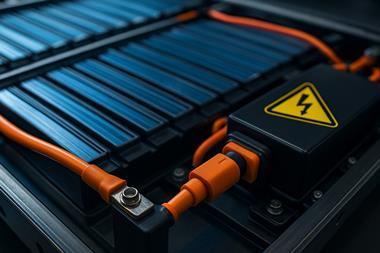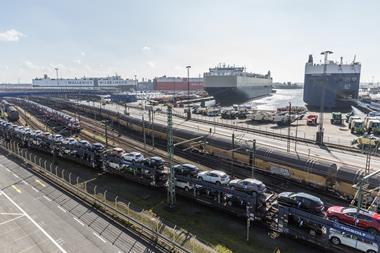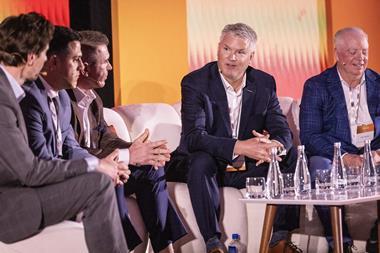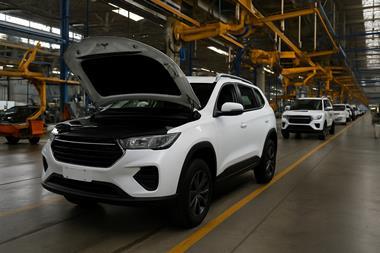 Egon Christ (left), senior manager for worldwide vehicle transportation and logistics at Daimler, reveals how the OEM plans to get the best from its logistics providers as it ramps up global production
Egon Christ (left), senior manager for worldwide vehicle transportation and logistics at Daimler, reveals how the OEM plans to get the best from its logistics providers as it ramps up global production
Already the largest manufacturer of trucks and commercial vehicles, Daimler has made no secret of its goal to take on BMW and Audi for the top spot in the global premium car market. The company’s Mercedes-Benz 2020 plan has set the manufacturer on a transformative path, having already introduced nine new models in the past two years, with another 13 planned by the end of the decade. This push is about more than volume; Daimler is launching redesigned models at new price points, across a broader range of segments and from several new production locations.
This strategy is significant for vehicle logistics. Firstly, Daimler anticipates a big increase in production. It has targeted a 50% global rise between 2012 and 2020 to about 2m units for passenger cars alone. Egon Christ, senior manager for worldwide vehicle transportation and logistics, the carmaker’s veteran head of outbound, says Daimler will need more flexible logistics, including increasing its use of multimodal transport.
Christ adds that Daimler needs to link together its changing network, which includes ‘transplanted’ production, such as the start of C-Class assembly next year at its plant in Tuscaloosa, Alabama. The company has also added production with alliance partners Renault Nissan in France and Slovenia, with more locations possible in the future, and with contract partners Valmet in Finland and Gaz in Russia.
In response to these changes, Daimler is rolling out new distribution concepts, including a hub-and-spoke model in Germany that will increase flexibility and rail transport, as well as more global logistics performance monitoring. But there is no magic bullet for the outbound supply chain, says Christ. While distribution-based production might be ideal for vehicle logistics, for example, and has been used in Daimler’s network, he is adamant that no one part of the supply chain should be optimised at the expense of the other.
On the other hand, Daimler’s ambitions are also reliant upon its outbound logistics providers. “The level of modification for our network is dependent on our logistics providers,” he says. “It is driven heavily by what services and quality they can offer us, especially in emerging markets.”
Christ thinks Daimler’s established providers in Europe have been too conservative in their attempts to grow in new markets. “We are prepared to support any kind of new developments in new markets, but due to missing engagement from providers, we currently do not see a wide field of possibilities,” he admits.
The good news is that there is more opportunity ahead. Daimler has recently put its entire 900,000 unit annual ro-ro volume into a single global tender to allow for more bundling and balanced flows. In China, where Daimler recently took a majority stake in its sales organisation, giving it responsibility for imports and local production, the Worldwide Transportation and Logistics department will get more involved in outbound network design for Chinese production. In North America, the combination of US, Canadian and Mexican distribution, along with the start of C-Class production, should lead to more multimodal transport and further opportunities to bundle the compnay’s volume.
Christopher Ludwig: Given the growth planned for Daimler’s Mercedes-Benz 2020 strategy, will vehicle logistics be a differentiator in Daimler’s objectives? If so, will it be more about controlling cost or fulfilling customer expectations?
Egon Christ: We consider vehicle logistics as a commodity with defined specifications for our partners to meet customer expectations. This includes promised delivery times and damage-free transportation at an affordable level. Therefore, we do not see vehicle logistics as a differentiator; instead, it is a supply element in a complex automotive supply chain and has to work as any other element would. Daimler’s brand promise – ‘the best or nothing’ – includes outbound, which means it has to work accurately and as promised to the customer.
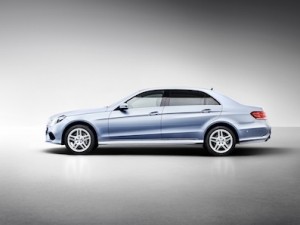
Christ: In our KPI monitoring system we measure delivery times. We focus on vehicle pick-up accuracy and compliance with contractual transit times. The given definitions are already ambitious, but achievable, while extraordinary events, like bad weather, are taken out of our evaluations. Generally, it is more important for us to deliver the car to the customer ‘as promised’ than to permanently tighten contractual specifications. We continuously acknowledge the degree of delivery date fulfilment with our performance-related payment system for providers, in which we motivate our partners with a bonus to exceed the agreed targets. We believe that this ‘self-adjusting system’ is the right concept to continuously improve promised delivery dates.
Daimler has a highly centralised approach to vehicle logistics under Egon Christ, who reports to the head of Worldwide Transportation and Logistics, Heiko Gaiser. Christ’s team combines logistics planning, network design and purchasing across cars, vans, trucks and buses, amounting to about 2m vehicles per year out of an annual sales total of 2.2m (subtracting out customer pickups and regions where importers or local sales organisations have delivery responsibility).
“If we were to split our procurement by business unit, we would cut a big cake into different slices, taking out opportunities for balanced flows and bundling,” says Christ. “We also think it’s appropriate to have planning and purchasing together,” he adds.“Vehicle logistics is different to buying screws or other commodities – there is more and more complexity and something gets lost if you plan a network and hand it over to someone else to do the purchasing.”
Daimler’s management in Europe tends to serve as a blueprint for other markets. A tracking system for real-time vehicle status has been rolled out globally from Stuttgart, for example. A central KPI monitoring system, which measures logistics provider performance and is linked to Daimler’s procurement and to its performance-related pay system for road transport, is also rooted in European operations. The company has been expanding this monitoring to other regions, such as North America, and is also considering extending performance-related pay to other transport services, such as ro-ro.
“A KPI measurement, adapted to each region and their specific requirements, is one of our most important tools and will be centralised in a newly developed IT system, which will also be effective for other commodities such as inbound logistics,” says Christ.
Last year, Daimler added two departments to its central management team in Europe. One is a multimodal group exploring opportunities to increase the carmaker’s rail and water-based transport in Europe.
Christ believes there is potential for Daimler to raise its multimodal volume in Europe, in which 20% of vehicles currently move by rail and 5% by sea or barge. The team has already showed results: Daimler began moving CLA export volumes from its plant in Kecskemet, Hungary to the port of Bremerhaven in enclosed wagons this past May.
“Due to the expansion of the model range produced in Hungary, this traffic will be significant in the future,” says Christ.
A second function, called Operations Europe, which Christ describes as Daimler’s in-house “fire brigade”, tackles capacity issues and other bottlenecks. “Operations Europe ensure a continuous flow of volumes down to the plant and that we have the right capacities in the supply chain,” he says. “They deal with model launches, new markets and network overloads, for example.”
Ludwig: Has Daimler invested further in any IT systems that will further reduce the order-to-delivery cycle?
Christ: Yes, definitely, and we have done a lot to have more supply chain visibility. One example is continuous real-time data messages at each arrival point in the chain in our system, which automatically adjust a vehicle’s ETA for dealers. This is a system with global scale and it will improve our delivery predictions tremendously.
Ludwig: You have spoken about smoothing the supply chain. Given the pressure on month-end and quarter-end delivery figures, is it feasible to achieve this?
Christ: Month-end and quarter-end delivery pressure is simply symptomatic of volatile global market demand. We can’t solve that issue with logistics, but have to manage it to meet a given day’s target. Flexibility will become even more important, which we think can be improved by network improvements.
One example is to have hubs close to the plants where we can do the respective smoothing or bundling 24 hours a day, seven days a week. Further flexibility is also achievable by combining several modes on a route. With our Hub North/Auto Terminal Bremen, close to the Bremen plant, and the Hub South, which will be close to plants in Sindelfingen and Rastatt, we will do exactly this in the near future. We are not just saying nice words, but we have a clear action plan.
Ludwig: Some OEMs avoid the hub-and-spoke model so as to eliminate extra handling. Why does the hub approach suit Daimler distribution?
Christ: Hub-and-spoke models have been implemented in the shipping and aviation industry with great success. The basic idea is to bundle network flows, to increase the utilisation of different transportation assets and to reduce costs via sharing of facilities and equipment. Nevertheless, hub-and-spoke is not the ultimate solution for each distribution problem.
If you take the Bremen hub, for example, the big disadvantage of the plant there had always been that we did not have a railway link. DB Schenker owned a compound nearby and it was logical to extend it to give us a direct connection to the railway.
Ludwig: These hubs will be open 24 hours – does this suggest that Daimler has had success in pushing after-hours deliveries elsewhere in the supply chain?
Christ: Making distribution more flexible starts with plants and ends with dealers. This year we have kept our Rastatt plant open 24 hours and next year we will do the same at Kecskemet, Hungary. Meanwhile, night deliveries are now quite normal for our passenger car distribution in Germany, where 60% of our dealers already accept night delivery, and our studies show that a further 30% are open to it. This encourages us to expand this model to other markets.
A good example is the US, where the share of dealers accepting night delivery is also increasing. In light of road congestion, especially in metropolitan areas, delivery at night is an important efficiency lever for our vehicle logistics partners as well.
Linking a global ro-ro network
Ludwig: Daimler has recently run a global tender for ro-ro shipping. Was this a new approach for ro-ro procurement?
Christ: This is the first time Daimler has tendered its entire global ro-ro network within one RFQ [request for quotation], including all commodities and business units. A total of approximately 900,000 units per year with close to 1,000 trades were involved, which included all passenger cars, vans, trucks and buses as well as business units such as Mercedes-Benz, smart, Freightliner, FUSO, Bharat Benz and Setra.
Ludwig: What are the benefits of this approach?
Christ:The main benefit is that you can re-shape and optimise your entire network independently from existing patterns or trade dependencies. This approach also reflects the situation in the ro-ro market, where most carriers build global

One big disadvantage is definitely the workload during such a tender because of its complexity and because our team has responsibility for both planning and procurement. It has taken almost ten months to do this tender.
Ludwig: Do you anticipate Daimler exports out of Germany and Europe will rise, or will this level off with rising regional production?
Christ:‘Transplanting’ and new models have a significant impact on vehicle flows, especially for North America and China. As you know, the new C-Class will be built in the US for the domestic market, while exports from Europe to North America continue to rise due to new models such as the CLA and the GLA. We also expect increasing volumes to the Far East, while exports from the US are also growing.
However, customers in China and the US expect ‘high-end cars’, such as the Mercedes S-Class or AMG models, to be ‘made in Germany’, which is why we expect growth for German exports too.
One of the most significant developments to come out of Daimler’s outbound logistics engineering is the use of a hub-and-spoke model. These hubs are designed to be located close to plants to combine volumes from multiple sites or ports, to operate 24/7, and to balance multimodal transport. Christ sees the hubs as a means to increase flexibility and to smooth the natural peaks and troughs that accompany the automotive business and seasonal cycles, such as at the end of the month or the quarter.
“The main reason for the introduction of multimodal distribution hubs is to gain more flexibility,” he says. “Such hubs allow coping with increasing volumes and volatile plant output, smoothing or bundling volumes for smaller or bigger markets without any time restrictions.”
The first hub will be located close to Daimler’s Bremen plant and will handle locally produced vehicles, imports and exports. The hub, which will be operational at the end of this year with storage space for 2,500 vehicles, is owned and operated by DB Schenker, a division of Germany’s state railway giant, Deutsche Bahn. The hub will have links to the rail network – something Christ admits the Bremen plant has always lacked.
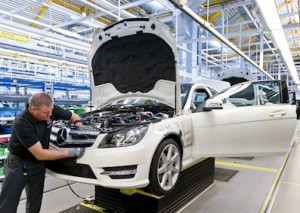
Christ sees such hubs as a way to overcome the constraints of the European vehicle logistics market and freight infrastructure. He feels that logistics providers are still largely regional, with small compounds spread across the European map rather than integrated into a network.
“If you look at the map of European vehicle logistics, you see that this is still a patchwork of mid-sized companies with small compounds everywhere,” he says. “The next level of distribution efficiency must lead to a situation where these compounds can become one big hub for distribution in a region like Bavaria, for example, rather than five compounds in the middle of nowhere.”
Ludwig: Will ro-ro capacity be sufficient to meet Daimler’s requirements in the coming years?
Christ:We expect vessel capacity and vehicle volumes to be in balance over the next couple of years. While the number of units to be transported is gradually increasing, so too is vessel size, and there is still potential to use available vessel capacity more efficiently. Nevertheless, there could be shortages on certain trades depending on volume fluctuation, which is most likely to be seen on trades from Europe to the Far East. At this point it is more difficult to make projections beyond 2015.
Tracking logistics performance
Ludwig: Are you hopeful that logistics providers will meet Daimler’s needs for its expansion plans?
Christ: It is logistics providers’ core business to meet the needs of OEMs. That is a business opportunity for them. Nevertheless, it is important to permanently stay in contact with suppliers. That’s why we have the European Carrier Day and other initiatives to keep companies in the loop and provide them the information they need.
Ludwig: Daimler had recently tracked declining KPI performance among European providers. Has there been any improvement or further decline?
Christ:There was a phase where there were problems, including a higher participation of subcontractors in our network. Carriers had reduced fleets, then had to add capacity when we increased our output. Firstly, we could detect that in our system, which we wouldn’t have been able to do without our measurement processes. We believe the problem was that subcontracted providers didn’t have the same level of training for handling and loading. We worked with our partners and agreed that carriers include the subcontractors in all their training so as to bring them to the same level of know-how. Today, the quality is better.
Subcontractors can be a reasonable support to correspond with volume peaks. Such flexibility is generally in Daimler’s interest. However, wherever an assignment is passed on to a subcontractor, it has to be in compliance with Daimler’s quality standards.
Ludwig: You have often called for more innovation among providers. Have you seen any improvement here?
Christ:The industry still seems to be conservative and not ready to question or reconsider existing processes. This is disappointing, especially compared to inbound logistics, where we see more customer orientation and concept evolution. Nevertheless some individual suppliers have showed innovation potential, such as emission-free final distribution technologies or other green logistics innovations. The new ECG academy module, Innovation Management, is also a positive signal.
Thinking about new NAFTA strategies
Ludwig: I understand that the NAFTA project will bring together Daimler’s regional operations and different business units. What kind of impact will this have on vehicle logistics?
Christ:Of course, we are assessing possibilities to support our ‘holistic outbound supply chain approach’ for factory-to-dealer responsibility in many different regions. But for NAFTA, we are not yet in a phase of having made any organisational decision.
Ludwig: Has the project led to any specific changes in the North American network so far?
Christ: In the past, the US and Canadian networks were completely separate, for example. Now we have started to combine and adjust distribution by using common ports and hubs as well as carriers. With the C-Class production in Tuscaloosa next year, the additional volume will further increase the synergies for the region.
Ludwig: Do you foresee using bundled flows or cross-regional hubs combining cars, vans and/or trucks, for example?
Christ: Within our department, our goal has always been to integrate as much as possible wherever it makes sense. While heavy trucks are different, including transport by ‘piggyback’ in North America, there is a lot of potential for vans. For the vehicle imports from Europe to North America, we share the ports and infrastructure for cars and vans. We see opportunities in sharing existing logistics centres and ports between our organisation in Canada, Mexico and the USA.
Ludwig: Are you concerned at all about the capacity levels for trucks and drivers in North America?
Christ: For passenger vehicle distribution, we currently see a more or less balanced situation. However, capacity constraints could occur at quarter or year-end because of seasonal peaks.
Ludwig: Are you exploring multimodal transport in the region?
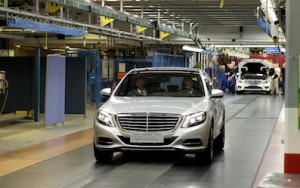
Christ: Daimler distribution in the US from the ports to the dealers is done today mainly by truck, while from the factory in Tuscaloosa we run a mixed truck and rail concept. C-Class production in Tuscaloosa will lead to higher rail use. For the past three years we have also used a rail concept for Sprinter distribution from our plant in Ladson, South Carolina.
Ludwig: What improvements do you expect in the NAFTA region in the coming years?
Christ: Production increases will affect the current transportation network and modes. The import volume will also further increase. The future network must handle these two main developments.
Our company would also appreciate more supply chain visibility, such as for vehicle status during planning and transportation. Furthermore, we would like to see a paperless delivery process to reduce administrative efforts.
Integrating volumes and standards in China
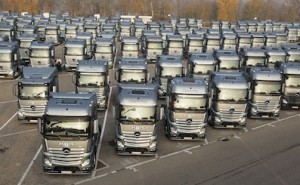
Christ: The three major ports: Tianjin, Shanghai and Guangzhou.
Ludwig: Will port and ro-ro capacity be adequate to meet Daimler’s needs in China over the coming years?
Christ: While we see further growth for volumes destined to China, we do not see any capacity constraints due to increasing local production. There has also been considerable investment in these ports. I was deeply impressed by the development at Tianjin when I was there, for example, including more than a kilometre of new facilities.
Ludwig: What services does Daimler use at terminals in China?
Christ: Daimler has implemented vehicle preparation centres and PDI workshops in each port, which enable us to rework according to market needs. The terminals are outsourced to providers, but are run with our systems and global standards.
A few years ago, after we took over responsibility for final delivery of imports following the high growth, we had to redesign everything in China. There weren’t sufficient PDI facilities and the existing network structure did not meet the needs of the predicted volume increases and necessary supply chain performance. Our central team went there, and along with adjusting the import process, we tendered for final distribution in China together with local partners and restructured our network to have three logistics partners for these three import areas. The new setup enabled us to cope with the new volumes, led to a higher service level and drastically reduced distribution time.
Ludwig: What is the shape of the Chinese distribution network compared to the US or Germany? Do you use distribution centres?
Christ: The main market for Mercedes-Benz products is along the coasts. Therefore, the average distribution distance is rather short compared to the US or even Germany. Thus, there is no need to consolidate or tranship vehicles after having left the VPC facilities at the ports. This might change in future as economic growth in other areas in the country creates increased demand for premium automobiles.
Ludwig: Do you envision taking more responsibility for local, BAIC Mercedes-Benz production?
Christ: Currently we don’t combine imports with local production, but Daimler has integrated its sales organisation in China, which our corporate logistics function is supporting. We have already started to redesign and adapt the existing network to include local production and the respective increase of volumes and dealerships.
Ludwig: How do you rate vehicle logistics providers in China?
Christ: We see room for improvement in terms of quantity and quality of the existing vehicle logistics supplier base.
Ludwig: Would you like to see more established providers from Europe expanding services here?
Christ: We would encourage not only European companies, but also our global supplier base to move toward BRIC markets. We have seen companies doing this quite successfully in the past. We believe the right way of doing it is an asset-based approach.

Christ: If suppliers came to our offices and proposed new services in China, we would be open for discussion to support them, since this would be beneficial to the transfer of knowledge and standardisation in the market. We actually see the opposite happening. Some providers that have stepped into China are going out again. Perhaps they lack the relevant management capacity or they see a certain risk, or they are simply not patient enough to build up the business over there. You need to commit for the long term in China, otherwise you will fail.
Also, we see European vehicle logistics companies working with local companies in China or in other markets, but there has been no joint approach, in which several European providers enter a market like China together in an alliance, which might be the more successful and less risky way of doing business.
Ludwig: What improvements for vehicle logistics do you hope to see in China over the next few years?
Christ: Along with a broader and more qualified supplier base, I would hope to see further standardisation of transport equipment and the introduction of trailer equipment for heavy commercial vehicles for road and rail.










